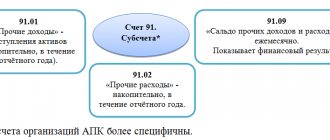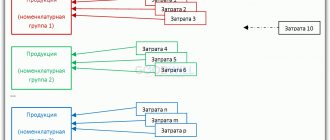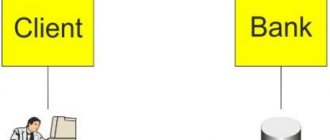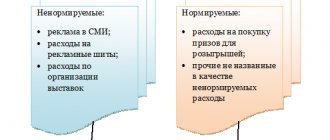Closing account 91 “Other income and expenses”
91 accounting accounts are closed depending on the period:
- the difference between credit and debit is reflected at 91.09;
- at the synthetic level monthly at 99;
- analytical levels of subaccounts are reset at the end of the year;
- in 1C, closing is automated;
- At the end of the year, the balance sheet is reformed.
Closing the month is, in essence, clearing the balances on some synthetic accounts. The law suggests that there should be no balance in the accounts responsible for collecting costs, income and expenses from core and other activities.
Types of income and expenses
In other words, in the organization’s balance sheet, only the assets and liabilities included in the financial statements, that is, the balance sheet, are transferred to the next month. Among the indicators that collect information about profits and losses, 91 accounts “Other income and expenses” are responsible for the additional activities of the enterprise.
It provides for maintaining mandatory sub-accounts:
- 91.01 “Other income” - formed on the loan.
- 91.02 “Other expenses” - formed by debit.
- 91.09 “Balance of other income/expenses” - loss is reflected on the debit side, profit on the credit side.
This account is not used for the sale of products (works, services), as it must contain information about all kinds of income and expenses not related to the production or performance of work (services). Income that is reflected on 91.01:
- sale of own assets;
- written off accounts payable;
- penalties and fines won in court;
- surpluses found during inventory;
- materials received after liquidation of fixed assets;
- revaluation of assets.
Accordingly, the wiring will look like this:
- Dt 01 (10, 62, 76) Kt 91.01.
Organizational expenses accumulating in account 91.2:
- accruals to reserves for overdue debts and upcoming holidays;
- commission for banking services;
- state registration fees;
- fines and penalties received from control authorities;
- penalties and compensation under business agreements;
- asset write-down;
- interest on loans and borrowings not related to core activities.
Entries for expense generation:
- Dt 91.02 Kt (01, 60, 62, 66, 68, 69, 76).
How to close a period?
At the end of the month, it is necessary to close account 91. For this, the third subaccount 91.09 is constantly used, which is designed to reduce turnover at the synthetic level to zero.
From the author! It shows the interim financial result from the turnover of other activities of the company, showing a profit on debit or a loss on credit.
After the positive or negative balance becomes known, the posting is made:
- Dt 91.09 Kt 99 “Profits and losses” - profit is reflected;
- Dt 99 Kt 91.09 – loss from the company’s activities is taken into account.
For example, Bubbles LLC at the end of the month had accumulated amounts in subaccounts, which are more convenient to view in tabular form:
Table 1. Analytics for subaccounts Name of incomeAmount of incomeName of expenseAmount of expense
| Scrap metal obtained from the liquidation of OS | 6 000,00 | Reserve accrued for PDZ | 50 000,00 |
| Overdue accounts payable with expired statute of limitations | 98 000,00 | Vacation reserve accrued | 300 000,00 |
| Sold a refrigerated display case made from our own OS | 1 000 000,00 | Received a fine from the Federal Tax Service | 2 000,00 |
| Penalty received under the contract | 400,00 | Bank service fee | 3 000,00 |
| TOTAL | 1 104 400,00 | 355 000,00 |
So, the balance at the end of the month is:
- 91.01 – in the amount of 1,104,400 rubles accrued to other income;
- 91.02 – in the amount of 355,000 rubles included in other expenses.
Thus, you can calculate the balance 91.09:
- 1,104,400 – 355,000 = 749,400 rubles profit received.
When closing the month, the accountant will make an entry in the program:
- Dt 91.09 Kt 99 – in the amount of 749,400 rubles.
Or you can show a simple double entry accounting:
Table 2. Balances in accounting Subaccount numberDebit turnoverCredit turnover
| 91.01 | 1 104 400,00 | |
| 91.02 | 355 00,00 | |
| 91.09 | 749 400,00 | |
| Total revolutions | 1 104 400,00 | 1 104 100,00 |
| Total account balance 91 | 0,00 | 0,00 |
Features of annual closure
According to the accounting rules, every month it is necessary to close exclusively the synthetic level of the account, without taking into account subaccounts. They accumulate analytical data all year long:
- By type of income/expenses.
- By cost item.
- By department.
At the end of the year, the accounting department must reform the balance sheet. This means that when closing 91 accounts, transactions must reset all analytical subaccounts that are subject to such an operation:
- Dt 91.01 Kt 91.09 – the accumulated balance in the subaccount is reset to zero;
- Dt 91.09 Kt 91.2 – accumulated expenses are closed.
The resulting result as of September 91 closes at 99 “Profits and Losses”, depending on the financial result of the company.
How can 1C help an accountant?
Automation of final operations significantly saves time when compiling reports. Therefore, 1C.8 versions 2.0 and 3.0 provide for a whole cycle of regulatory operations. They must be carried out gradually, strictly in the sequence in which they were conceived.
Important point! Violation of the sequence of routine operations leads to incorrect data in analytical reports. We must remember that some of the operations are interconnected. It is impossible to calculate profit if cost accounts are not reset.
Regular operations are located in the “Accounting, Taxes and Reporting” menu, “Period Closing” section, “Month Closing” subsection. Here in the third stage you can see “Closing 90, 91 accounts”.
This processing deals with zeroing the required account. 91, just like other accounts, is not closed if there are errors. Incomplete cost items and other analytical sub-contos may result in the transaction being rejected. You can learn more about how the operation works from the video:
Empty subcontos form negative balances in analytics, which confuse the balance sheet, leading movements into chaos. Therefore, it is necessary to fill out the analytics very carefully and thoughtfully, entering primary operations in the program.
Source: https://moneymakerfactory.ru/articles/zakryitie-scheta-91/
Typical transactions for account 91
Debit account turnover is formed by the company's expenses, credit turnover is created due to income. For 91 accounts, organizations open 3 sub-accounts:
- 91.1 for the income part (loan entries).
- 91.2 for the expense base (debit entries).
- 91.9 to form the overall balance for income and expense transactions.
Income can be recorded by debit 91.1 in correspondence with the accounts:
- 10 in case of receipt of returnable materials;
- 08 when reflecting the fact of receipt of assets in accordance with the exchange agreement;
- 14 if the reserve amount is restored.
Until the moment when account 91 is closed, it is necessary to reflect the expense portion of loan 91.2 in correspondence, for example, with the accounts:
- 52 in cases of writing off negative exchange rate differences;
- 60 for additional costs incurred to obtain a loan.
closing account 91 in 1s.8
Quote Ksyusha 758 Well, there is no pack, but we trained the workers, bought a punishment, equipment, depreciation, tools, a truck crane - all this will not be 92
Then let the sums weigh. Write it down when you start producing))
Quote Ksyusha 758 Well, there is no pack, but we trained the workers, bought a punishment, equipment, depreciation, tools, a truck crane - all this will not be 92
Then let the sums weigh. Write it down when you start producing))
Page 3
Quote Ksyusha 758 Well, there is no pack, but we trained the workers, bought a punishment, equipment, depreciation, tools, a truck crane - all this will not be 92
Then let the sums weigh. Write it down when you start producing))
Page 4
Quote Ksyusha 758 Well, there is no pack, but we trained the workers, bought a punishment, equipment, depreciation, tools, a truck crane - all this will not be 92
Then let the sums weigh. Write it down when you start producing))
Page 5
Quote Ksyusha 758 Well, there is no pack, but we trained the workers, bought a punishment, equipment, depreciation, tools, a truck crane - all this will not be 92
Then let the sums weigh. Write it down when you start producing))
Accounting Features
The peculiarity is that entries for the first four sub-accounts are accumulated throughout the year. At the end of the year, the account is closed, as a result of which the balance of all subaccounts is reset to zero.
The financial result is calculated at the end of each month and is reflected in the 9th subaccount of account 90, so the total balance in account 90 at the end of the month is zero.
Accounting example:
The organization sells goods subject to VAT. The cost price is collected from the purchase price of goods reflected in account 41, and selling expenses collected in account. 44.
The initial data is as follows:
- a batch of goods with a total cost of 100,000 rubles was purchased;
- sales expenses amounted to 10,000 rubles;
- the sale of this batch was carried out for a total cost of 236,000 rubles, including VAT.
Postings to account 90:
During each month, revenue is reflected, costs are formed and VAT is calculated on all transactions related to ordinary activities. At the end of the month, the financial result for the month is calculated, which is reflected in the 9th subaccount of account 90 in correspondence with account 99.
At the end of the year, the procedure for closing account 90 should be carried out.
How to close a 90 account?
Each separate subaccount (from 1st to 4th) accumulates a balance - a credit balance for the first subaccount, a debit balance for the rest.
At the end of the year, each subaccount has a total balance accumulated over 12 months. The task is to reset this balance for each subaccount, thereby the entire account 90 will have a balance of 0.
How to close account 90:
- 1st subaccount - posting D90.1 K90.9 is performed for the amount of the credit balance at the end of the year;
- from the 2nd to the 4th subaccount - posting D90.9 K90.2 (90.3, 90.4) is performed for the amount of the debit balance for each subaccount;
- 9th subaccount - as a result of the actions indicated above, the balance on it will be equal to 0.
Thus, the postings for closing account 90 look like:
- D90.1 K90.9 - the first one closes;
- D90.9 K90.2 - the second one closes;
- D90.9 K90.3 - the third closes;
- D90.9 K90.4 - the fourth one closes.
The balance for each subaccount and for account 90 as a whole is equal to 0 at the end of the year. At the beginning of the year, the account should be reopened, again starting to accumulate cost, revenue and taxes on it.
Example of closing account 90:
We have these numbers at the end of the year. Black shows the final balance for each subaccount at the end of the year.
To close an account, you need to make the following transactions:
| Shur1cIT | |
| Shur1cIT | subconto at 91.01 and 91.02 are all filled in, only 91.09 is missing, but it is closed |
| Amra | (1) Closes 91.09 or does it post to 91.09? Is there a balance for 91 accounts in total after all the regulatory ones? |
| Shur1cIT | after the reformation, the balance on 91.01 91.02 goes away but appears on 91.09 small, but the balance 91 should completely go away when closing? how to check? |
| Murka | (1) During the year, account 91 for subaccounts is not closed. Only the difference between 91.01 and 91.02 is written off through the account 91.09. Account 91 is closed if it has no balance overall. |
| Murka | (3) Are you closing the year? |
| Shur1cIT | yes we are closing the year |
| George1 | Shur1cIT - it is very doubtful that you are closing the year. maybe a month? |
| Murka | In general, closing 91 is so simple that there shouldn’t be any mistakes there. |
| Shur1cIT | Document closing 91.91 accounts for the period December 2011 or am I doing something wrong? |
| George1 | (9) what you want in (0) is called balance sheet restructuring |
| Murka | (9) You are doing everything right. I won’t say anything without a base; after the month is completely closed, 91 should close at 0, including all subaccounts. |
| Amra | (8) It happens) If, for example, subaccounts are mixed up, they will make entries in debit 91.1 or credit 91.2 |
| Murka | (10) By the Reformation. |
| Amra | (11) Incorrect. 91 will close completely after restructuring, and not closing 91 accounts |
| George1 | (13) yes, exactly |
| Murka | (12) By the way, yes) |
| Murka | (14) in (11) it is written “after the complete closure of the month”, and not “after completing the operation Closing accounts 90, 91” |
| maxmb | 1 Analytics for other income and expenses are not specified. Turnovers were detected on account 91, for which the entries do not indicate items of other income and expenses in the document Write-off from current account 00000000031 dated 01/10/2012 13:29:16. It is recommended to fill out the “Subconto” column in this document |
| maxmb | Doesn't he write something like that? |
| Shur1cIT | no he doesn't write that |
| Shur1cIT | 91.01 movements on credit 91.02 on debit of this account she doesn’t even try to write off only during reformation |
| Murka | (21) This is how it should be. After the reformation, everyone should go to 0. |
| DailyLookingOnSunset | (21) We have these woodpecker squirrels who did such wiring, it seems they all quit. |
Account 91 - features of accounting for other income and expenses in 2021
> accounting > Account 91 - features of accounting for other income and expenses in 2021
In the previous article, we examined the accounting of income and expenses received from the normal activities of the organization. Other income and expenses are recorded on 91 accounting accounts. The data from this account also forms the final financial result of the enterprise.
In its structure, account 91 “Other income and expenses” is in many ways similar to account 90 “Sales”. It also consists of several subaccounts; income, expenses and financial results are reflected in different subaccounts.
What can be classified as other income and expenses?
Account 91 is closed based on the results of the reporting period, taking into account the amounts of income in the form of:
- proceeds from operations related to the rental of property (intangible and fixed assets);
- dividends when participating in the capital of other companies and interest on purchased securities;
- one-time receipts of funds from the sale of materials and objects from fixed assets;
- amounts of fines and penalties paid by counterparties under supply and service contracts;
- positive results of asset revaluation;
- exchange rate differences when conducting currency transactions.
Closing 91 accounts involves writing off both the income and expenses of the enterprise, including:
- costs of renting property;
- interest accrued on loans;
- commission fees to banks;
- monthly contributions to reserves;
- compensation for losses, payment of fines;
- depreciation of assets;
- charitable payments.
Closing the month in accounting: an example for novice accountants
Let's look at the process of “closing the month” for a real company providing services. Once again, let’s learn to “look at the turns.”
According to the basics of accounting theory and our new knowledge, let's try to predict what we should see after the “closing of the month.” For clarity, let’s take as a basis the Turnover Balance Sheet (TSV) of our enterprise. Here is an example of OSV.
Is this not what we expect to see?
- Account 26 should have no balance at the end of the month. those. BalanceEndingDebit(SKD) = 0
- Accounts 90 and 91 must be without balance
- Some amounts should appear in the Turnovers for the period for account 99
We launch the procedure “Closing the month”
Let's see how our turnover has changed.
I'll comment a little.
Look, account 26 at the end of the month was “closed” - it became 0. This is good. Here's a wiring diagram showing how it happened.
As we can see, expense accounts “transfer” their accumulated amounts from their Credit to Debit account to the financial result account. Remember the financial result formula? What accounts are involved?
So, Debit 90 and 91 accounts collect the expenses of our company for the current month. Now we can calculate the financial result for each of them. Calculating the financial result is some kind of action on 90, 91 accounts. As you remember, accounts 90 and 91 after summing up the financial result should be equal to 0. And the final result of financial activity will be on account 99.
Zero balances for accounts 90 and 91 should be for the account as a whole. Sub-accounts of these accounts will have balances until December 31, pending the procedure - balance reformation. But more on that later.
This is how the situation looks in our SALT for accounts 90, 91 and 99. This situation arises after the “transfer” of expenses to account 90, BUT before closing 90, 91.
Look, I have highlighted key accounts from the entire SALT to show the intermediate stage of “closing the month”. We see that account 26 has been closed: its balances are zero. And, in our case, the amount of account 26 was displayed in the Debit of account 90.
https://www.youtube.com/watch?v=FLkYKZ6Ubsg
In our example, the company has only account 26. If there were an account 44, it would also be closed and the amount from it would go to the Debit of account 90.
Thus, Debit 90 of account collects amounts from the company’s expense accounts, plus accumulates the cost of goods sold and products. Cost, as you understand, is available to manufacturing and trading companies. For us, only accumulated expenses from account 26.
Now we see that on accounts 90 and 91 different amounts were formed for Debit Turnover (DO) and Credit Turnover (CR). It turns out that for each of these accounts there is a final balance: 1705778.54 and 11374.53. Now it doesn’t make much difference for us where this balance is - in Debit or Credit. Only one thing is important to us:
Closing accounts 90 and 91 implies such actions so that the balance turns to zero. Those. we must make such entries for each account in correspondence with 99 so that our numbers - 1705778.54 and 11374.53 - go away. Those. the remainder would become zero. This is the rule for closing a total of 90 and 91 accounts - the balance on them should be zero.
And in order for the balances to become zero, we must transfer the existing differences between DO and KO (these are final balances) by posting to account 99. In other words, for account 90 we will “add” 1705778.54 to Debit.
— for 91 accounts we will “add” 11374.53 to the Credit
The following report shows how we “add the necessary numbers” through postings, thereby closing accounts 90 and 91. The closure of these accounts will be correct if, after that, their balances at the end of the period (month) become 0.
As you can see, the closure of accounts 90 and 91 goes through their internal subaccounts 90.9 and 91.9 in correspondence with account 99. Where 90.9 (91.9) will appear in the Debit or Credit entry depends on where there are not enough amounts so that the account at the end of the period gives 0.
How to close 91 accounts
- Banks
- Loans
- Insurance
- Finance
- Forex and stock exchange
Income and expenses are reflected on account 91 monthly. It has no balance at the end of the year. However, the account turnover continues to be recorded. How to close account 91 at the end of the year? To do this, carry out a balance sheet reformation.
Income and expenses are reflected on account 91 monthly. It has no balance at the end of the year. However, the account turnover continues to be recorded. How to close account 91 at the end of the year? To do this, carry out a balance sheet reformation.
Reformation is an operation that records the financial result of a company for the year. To do this, the accountant transfers the final balance of accounts 90 “Sales”, 91 “Other income and expenses” to account 99 “Profits and losses”. As a result, at the end of the year the balance of these accounts should become zero. Then the balance from account 99 is written off to account 84 “Retained earnings (uncovered loss).”
Editorial advice: it is convenient to fill out financial statements in the accounting program "Bukhsoft Online", it always contains up-to-date forms. In addition, the program updates itself, without intermediaries.
What subaccounts are opened for account 91
This subaccount reflects the financial result of other transactions. Sub-accounts are opened for account 91:
- 91-1 “Other income”. As the credit of this subaccount is received, income from other transactions is reflected;
- 91-2 “Other expenses”. All expenses for other transactions are written off to the debit of this subaccount;
- 91-9 “Balance of other income and expenses.”
If the total credit turnover of subaccount 91-1 is greater than the debit turnover of subaccount 91-2, then the difference between them forms profit. If the total credit turnover of subaccount 91-1 is less than the debit turnover of subaccount 91-2, then the difference between them forms a loss.
When closing the reporting period, the difference between the credit turnover in subaccount 91-1 and the debit turnover in subaccount 91-2 is reflected in account 99 “Profits and losses” subaccount “Profit (loss) before tax” in correspondence with subaccount 91-9:
Debit 91-9 Credit 99 subaccount “Profit (loss) before tax” - reflects profit on other operations for the reporting period;
Debit 99 subaccount “Profit (loss) before tax” Credit 91-9 – loss on other transactions for the reporting period is reflected.
Entries for subaccounts 91-1, 91-2, 91-9 are made on an accrual basis from the beginning of the year. During the year these subaccounts are not
are closing. Their closure occurs when the balance sheet is reformed.
Example In January, Alpha LLC rented out property and paid interest on the loan. Renting out property is not the main activity of the organization. The accrued amount of rent is RUB 59,000. (including VAT – 9000 rubles). The amount of interest on the loan is RUB 30,000.
As of January 31, Alpha’s accounting records reflected the following data:
- for the loan of subaccount 91-1 - rent in the amount of 59,000 rubles;
- on the debit of subaccount 91-2 - VAT on rent in the amount of 9,000 rubles;
- on the debit of subaccount 91-2 - interest for using the loan in the amount of 30,000 rubles.
On January 31, Alpha's accountant closes the reporting period. He does the wiring:
Debit 91-9 Credit 99 subaccount “Profit (loss) before tax” – 20,000 rubles. (59,000 rubles – (9,000 rubles + 30,000 rubles)) – profit on other transactions for January is reflected.
How account 91 is closed at the end of the year
To close account 91 you need to make internal transactions to this account:
Debit 91-1 Credit 91-9 – sub-account 91 -1 is closed;
Debit 91-9 Credit 91-2 – sub-account 91-2 is closed.
As a result of the entries made, the debit and credit turnovers on the subaccounts opened to account 91 will be equal to each other. Therefore, at the end of each month, account 91 will have a zero balance.
But in sub-accounts opened to these accounts, amounts accumulate throughout the year. They will need to be reset on December 31st at the reformation.
How can 1C help an accountant?
Automation of final operations significantly saves time when compiling reports. Therefore, 1C.8 versions 2.0 and 3.0 provide for a whole cycle of regulatory operations. They must be carried out gradually, strictly in the sequence in which they were conceived.
Important point! Violation of the sequence of routine operations leads to incorrect data in analytical reports. We must remember that some of the operations are interconnected. It is impossible to calculate profit if cost accounts are not reset.
Regular operations are located in the “Accounting, Taxes and Reporting” menu, “Period Closing” section, “Month Closing” subsection. Here in the third stage you can see “Closing 90, 91 accounts”.
This processing deals with zeroing the required account. 91, just like other accounts, is not closed if there are errors. Incomplete cost items and other analytical sub-contos may result in the transaction being rejected. You can learn more about how the operation works from the video:
Empty subcontos form negative balances in analytics, which confuse the balance sheet, leading movements into chaos. Therefore, it is necessary to fill out the analytics very carefully and thoughtfully, entering primary operations in the program.
Closing the month: postings and examples
And then, too, at the close of the month, I looked for why the balance remained.
Murka (23) I don’t want to upset you, but 91.01 and I have to go on loan. And 91.02 - by debit. Shur1cIT we have posting 91.9 generated every month by closing the month but there is no subconto where the subconto is set up? Murka (25) there is no need for a subconto) Solo Make a SALT for 91 account with control NU=BU+SHE+IT Perhaps there is an error| Sum | Operation | Debit | Credit |
| Closing subaccount 1 | 90.1 | 90.9 | |
| Closing subaccount 2 | 90.9 | ||
| 180000 | Closing subaccount 3 | 90.9 |
As part of the balance sheet reform, the company is required to close accounts 90 “Sales”, 91 “Other income and expenses” and 99 “Profits and losses” at the end of the year. Let's look at how account 91 is closed using examples with postings.
Use the completed example of a company's balance sheet:
Keep your accounting records in the BukhSoft program. It is suitable for organizations and individual entrepreneurs. The program includes uploading transactions to 1C, automatic generation of all reports and much more. Try it for free:
Reform balance online





